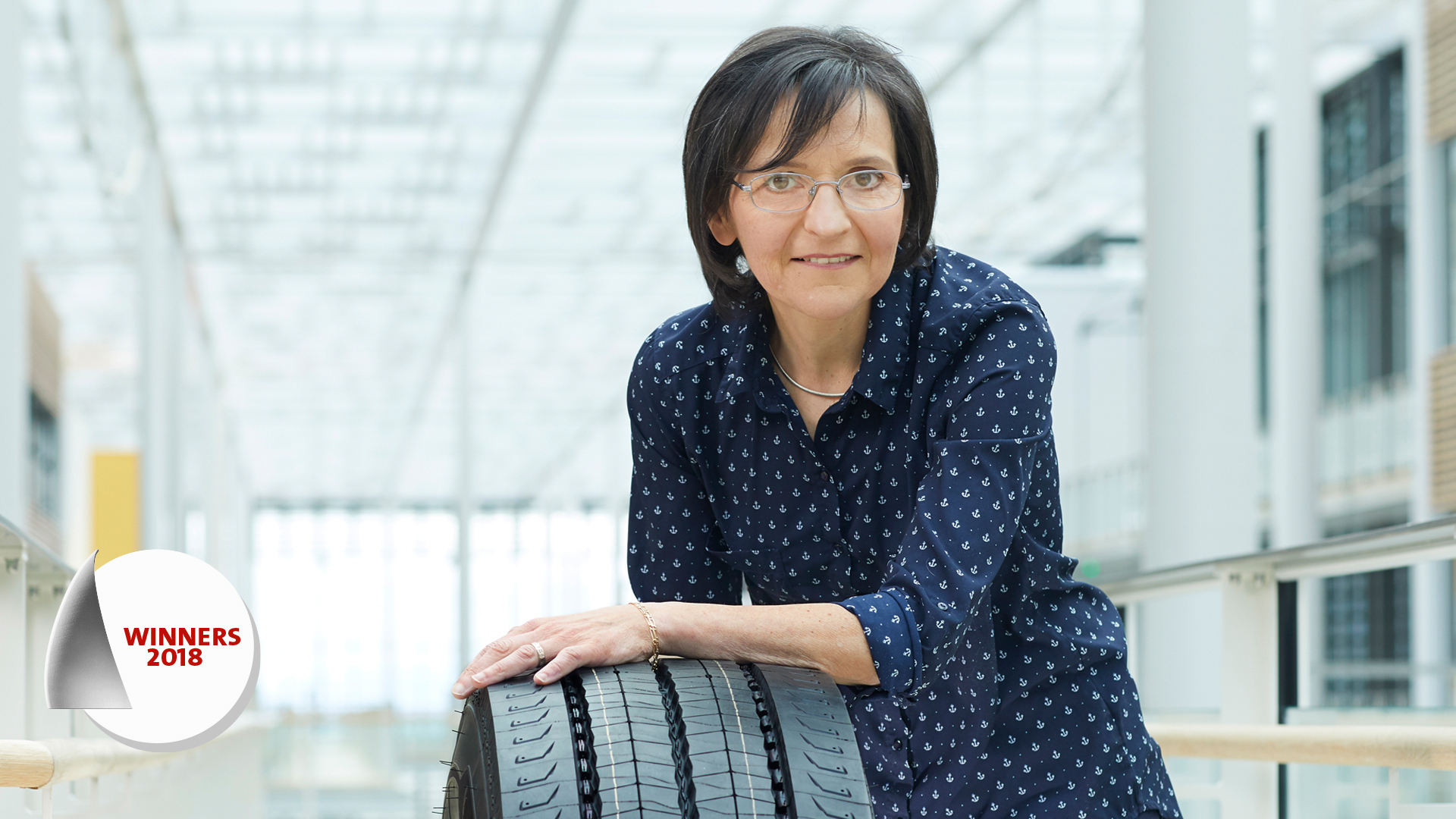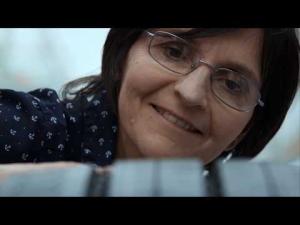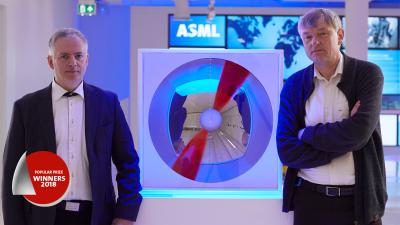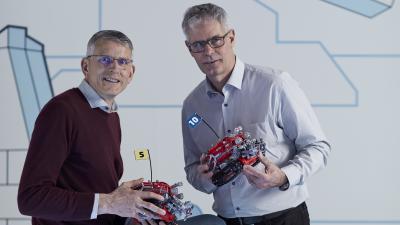Agnès Poulbot and Jacques Barraud†
Auto-regenerating tyre tread
Winners of the European Inventor Award 2018
A new generation of automotive tyres for heavy weights relies on applied mathematics for a significant performance boost, thanks to French researchers Agnès Poulbot and Jacques Barraud. Marketed by multinational tyre manufacturer Michelin, their clever tyre-tread design obtained by 3 D metal printing not only increases durability, but also significantly decreases fuel consumption and carbon dioxide (CO2) emissions while safeguarding a better performance of used tyres and their usage in all seasons to maximum level of wear.
Tyres are among the unsung heroes of automotive technology. They help absorb bumps on the road, ensure safe traction and provide both low rolling resistance to save fuel and the durability necessary for thousands of kilometres of travel.
Tyre design has come a long way since André Michelin and his brother Édouard at the Michelin Tyre Company (Compagnie Générale des Établissements Michelin) introduced the first removable rubber tyres for automobiles in 1895. Finding the perfect balance between grip, durability and reduced rolling resistance has kept materials scientists and tyre experts hard at work over the years.
In 2013, Michelin researchers Agnès Poulbot and Jacques Barraud patented an innovative tyre-tread design that "auto-regenerates" as it wears down, reducing rolling resistance, increasing fuel efficiency and extending tyre lifespan by up to 20%.
Marketed as the RegenionTM tyre technology, and available for heavy vehicles since 2013 and passenger cars since 2016, the patented design offers another significant benefit: upgrading a vehicle to Regenion tyres results in 3 724 kg fewer CO2 emissions per tyre lifespan compared with conventional models.
Societal benefit
Pollution from cars and lorries presents a mounting problem in cities around the world. The European Commission estimates that cars are responsible for around 12% of total European Union (EU) emissions of CO2, the main greenhouse gas. Heavy-duty vehicles produce around 25% of CO2 emissions from road transport in the EU and around 5% of the EU's total greenhouse gas emissions.
Using tyres with lower rolling resistance is one way to reduce emissions, which is why, in 2012, the EU introduced tyre labels to rate sustainability and performance. All tyre models featuring Poulbot and Barraud's invention received the top AAA rating for fuel efficiency and the shortest braking distance under wet conditions.
According to Poulbot, the Regenion tread design saves 26 grammes of CO2 emissions per kilometre, which adds up to 2.6 tonnes less CO2 over 100 000 kilometres. In addition, the tyres help reduce noise pollution and conform with noise regulations introduced in 2016 by the European Parliament.
Economic benefit
Patent holder Michelin is one of the biggest manufacturers of tyres worldwide and reported sales of 170 000 tyre units incorporating the invention in 2017. The company forecasts that it will sell 670 000 PL units featuring Regenion technology by 2019, which would amount to 15% of its heavy-duty tyre sales. By 2022, Michelin expects Regenion to generate 30% of heavy-duty tyre sales.
Essentially, the tyre "auto-regenerates" as it wears down. The tyre tread is optimised for minimal energy dissipation and reduced rolling resistance in order to secure the best possible performance during its lifetime.
Agnès Poulbot worked with Michelin's senior expert in tyre design and production for heavy vehicles -Barraud - to prepare the design for manufacturing. The two created a special mould to realise the tread patterns by 3D metal printing and enable production on an industrial scale.
How it works
The industry standard consists in moulding tyres to produce a single-layer tread design made with a specific pattern and depth. But using her insights as a mathematician and expert in 3-D modelling, Poulbot visualised the tyre tread as a stratum composed of multiple layers. Her computer-generated tyre design is based on vertical layers of tread within each tyre.
When the tyres are first mounted, only the outer traction layer is visible. Over time, the first layer wears away to reveal a new tread - featuring specially positioned ridges and grooves - from underneath. This second layer also wears away in time, revealing a third.
Essentially, the tyre "auto-regenerates" as it wears down, and each layer features only a shallow tread pattern, optimised for minimal energy dissipation and reduced rolling resistance.
The inventors
Jacques Barraud was born in 1958 in Cholet in the west of France. He joined Michelin in 1979 and worked as an engineer, trainer and project leader before he passed away in 2016.
When Agnès Poulbot started working at Michelin in 1996, Jacques Barraud accompanied her through her training. The two worked together on the Regenion tyre for four years and frequently went out jogging together in Clermont-Ferrand.
Agnès Poulbot was born in Paris in 1967 and studied mathematics and computer sciences in Grenoble. After earning her PhD in applied mathematics at the University of Grenoble in 1993, she joined the French Alternative Energies and Atomic Energy Commission in Grenoble, where she contributed to the development of an image reconstruction algorithm for use in medical computer tomography.
In 1996, Agnès Poulbot started working at Michelin, where she now holds the position of senior expert in pre-development and advanced research for truck and bus tyre design for the European market. A mother of five, the maths expert loves solving logic puzzles with her family.
Did you know?
Poulbot could be the sixth female inventor to win at the European Inventor Award and the second female winner in the "Industry" category. Previous female Award winners include Helen Lee, whose diagnostic solutions for developing countries were a favourite with the public, winning the Popular Prize in 2016. Read our feature on past female winners and other notable female inventors.
Poulbot is also not the first finalist with an invention based on complex mathematics. Another example is the multinational team behind the complex signal modulation techniques for Galileo - the next-generation satellite navigation system - who won in the "Research" category in 2017.
Other Award finalists whose inventions rely on serious number-crunching include Joan Daemen, Pierre-Yvan Liardet and team, whose cryptographic techniques safeguard bank cards (2016; Industry) and Carles Puente and team, whose fractal-based antennae power mobile internet connections (2014; SMEs).
Media gallery
Patent numbers:
Contact
European Inventor Award and Young Inventors Prize queries:
european-inventor@epo.org Subscribe to the European Inventor Award newsletterMedia-related queries:
Contact our Press team#InventorAward #YoungInventors








